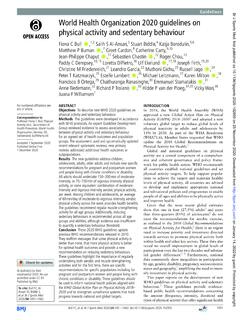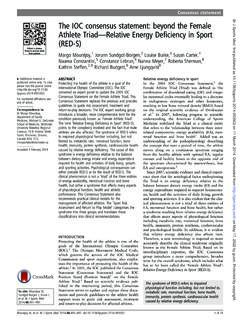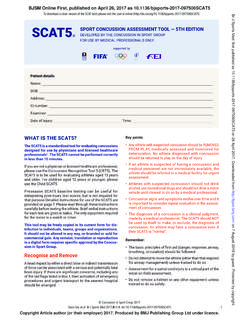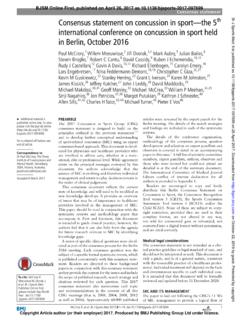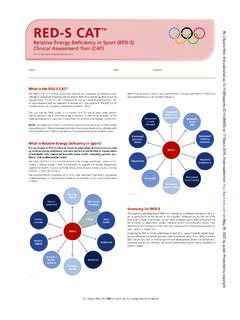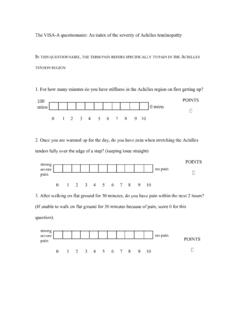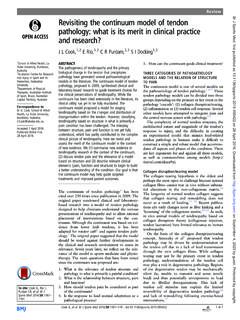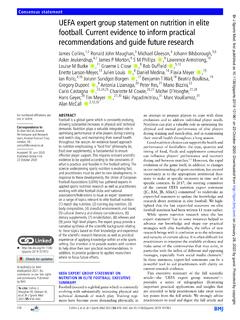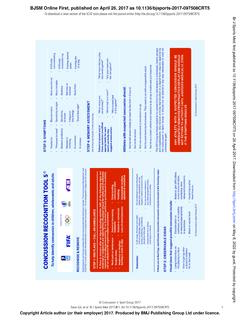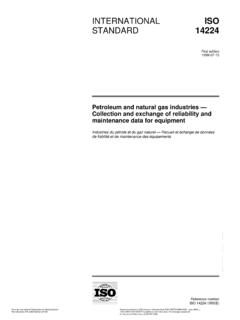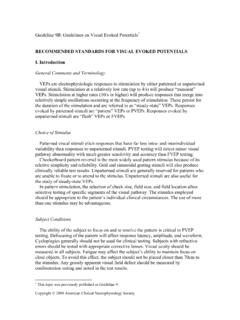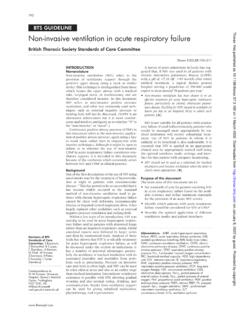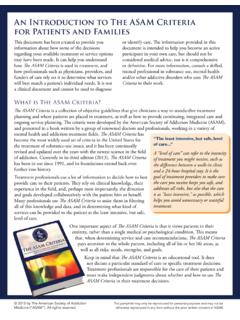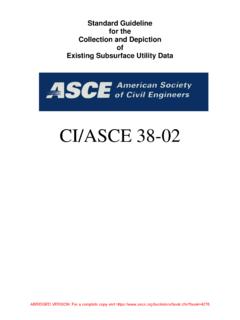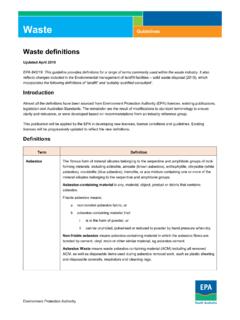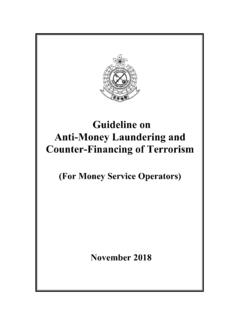Transcription of Diagnosis, treatment and prevention of ankle sprains ...
1 1 of 15 Vuurberg G, et al. Br J Sports Med 2018;52:956. , treatment and prevention of ankle sprains : update of an evidence-based clinical guidelineGwendolyn Vuurberg,1,2,3 Alexander Hoorntje,1,2,3 Lauren M Wink,1,4 Brent F W van der Doelen,1,2,3 Michel P van den Bekerom,5 Rienk Dekker,6 C Niek van Dijk,1,2,3 Rover Krips,7 Masja C M Loogman,8 Milan L Ridderikhof,9 Frank F Smithuis,10 Sjoerd A S Stufkens,1 Evert A L M Verhagen,3,4,11 Rob A de Bie,12 Gino M M J Kerkhoffs1,2,3 Consensus statementTo cite: Vuurberg G, Hoorntje A, Wink LM, et al. Br J Sports Med 2018;52 numbered affiliations see end of toGwendolyn Vuurberg, Academic Medical Center, Amsterdam 1105 AZ, The Netherlands; g.
2 Vuurberg@ amc. uva. nlReceived 26 May 2017 Revised 11 January 2018 Accepted 2 February 2018 Published Online First 7 March 2018 AbsTrACTThis guideline aimed to advance current understandings regarding the diagnosis, prevention and therapeutic interventions for ankle sprains by updating the existing guideline and incorporate new research. A secondary objective was to provide an update related to the cost-effectiveness of diagnostic procedures, therapeutic interventions and prevention strategies. It was posited that subsequent interaction of clinicians with this guideline could help reduce health impairments and patient burden associated with this prevalent musculoskeletal injury.
3 The previous guideline provided evidence that the severity of ligament damage can be assessed most reliably by delayed physical examination (4 5 days post trauma). After correct diagnosis, it can be stated that even though a short time of immobilisation may be helpful in relieving pain and swelling, the patient with an acute lateral ankle ligament rupture benefits most from use of tape or a brace in combination with an exercise programme. New in this update: Participation in certain sports is associated with a heightened risk of sustaining a lateral ankle sprain. Care should be taken with non-steroidal anti-inflammatory drugs (NSAIDs) usage after an ankle sprain.
4 They may be used to reduce pain and swelling, but usage is not without complications and NSAIDs may suppress the natural healing process. Concerning treatment , supervised exercise-based programmes preferred over passive modalities as it stimulates the recovery of functional joint stability. Surgery should be reserved for cases that do not respond to thorough and comprehensive exercise-based treatment . For the prevention of recurrent lateral ankle sprains , ankle braces should be considered as an efficacious lateral ankle sprain (LAS) is a frequently incurred musculoskeletal injury, with a high prevalence among the general population and individuals who participate in 2 About 40% of all traumatic ankle injuries occur during sports.
5 For indoor sports, an incidence of 7 LAS per 1000 exposures has been Despite the high prevalence and incidence of LAS injuries, it has been reported that only approximately 50% of individuals who incur a LAS seek medical A large propor-tion of individuals who sustain a LAS will develop chronic ankle instability (CAI).5 7 CAI may be defined as persistent complaints of pain, swelling and/or giving way in combination with recurrent sprains for at least 12 months after the initial ankle sprain,8 11 which in turn may lead to (long-term) absenteeism from work and sports.
6 treatment costs in combination with sick leave lead to a high socioeconomic 7 12 Additionally, associa-tions with joint degeneration and osteochondral lesions have been reported over Adequate diagnosis, treatment and prevention of injury recur-rence could forestall the development of long-term injury-associated symptoms and hence substantially reduced the associated socioeconomic the increasing number of published studies on this topic, heterogeneity in treatment strategies persists worldwide. This necessitated the development of an international evidence-based clinical Since the publication of this guideline, additional studies have been undertaken and published on this order to provide an update of the multidisci-plinary clinical guideline, a multidisciplinary guide-line committee was formed.
7 The committee included health professionals who were directly involved in the care of patients with LAS in clinical practice or research environments and included general prac-titioners, emergency physicians, musculoskeletal radiologists, occupational physicians, orthopaedic surgeons, rehabilitation physicians, physical ther-apists, athletic trainers, sports massage therapists, sports physicians and trauma surgeons. This clinical guideline incorporates the most recently published peer-reviewed literature on the topic of LAS injury. The aim of this updated evidence-based clinical guideline is to facilitate uniformity of diagnosis and treatment of acute LAS injury, with the primary purpose of reducing the long-term injury-associated symptoms resulting from this prevalent multidisciplinary guideline committee devel-oped this update in order to assist all healthcare professionals, in both primary and secondary care settings, involved in the care of patients who have sustained an acute LAS injury.
8 These include general practitioners, emergency physicians, musculoskel-etal radiologists, occupational physicians, ortho-paedic surgeons, rehabilitation physicians, physical therapists, athletic trainers, sports massage thera-pists, sports physicians, trauma surgeons and other professionals involved in lower extremity muscu-loskeletal injuries. This updated Clinical Prac-tice Guideline (CPG) will enable these healthcare on December 21, 2020 by guest. Protected by J Sports Med: first published as on 7 March 2018. Downloaded from 2 of 15 Vuurberg G, et al. Br J Sports Med 2018;52:956.
9 StatementTable 1 Classification of methodological quality of individual studiesClassification of studiesInterventiondiagnostic accuracy of researchdamage or side effects, aetiology, prognosis*A1 Systematic review of at least two independently conducted studies of A2 levelA2 Randomised double-blind comparative clinical research of good quality and sufficient sample sizeResearch relative to a reference test (a golden standard ) with predefined cut-off points and independent assessment of the results of a test, on a sufficiently large series of consecutive patients who all have had the index and reference testProspective cohort study of sufficient sample size and follow-up duration adequately controlled for confounding and selective follow-up is sufficiently excludedBComparative research, but not with all the features as mentioned under A2 (this includes patient control research, cohort study)
10 Research relative to a reference test, but not with all the attributes that are listed under A2 Prospective cohort study, but not with all the features as mentioned under A2 or retrospective cohort study or patient monitoring researchCNot comparative researchDOpinion of experts*This classification only applies to situations in which due to ethical or other reasons controlled trials are not possible to perform. If these are possible, then the classification applies to 2 Level of evidence of conclusionsEvidence levelConclusions based on1 Research of level A1 or at least two examinations of level A2 performed independently of each other with consistent results2 One examination of level A2 or at least two examinations of level B.
